Home / Pi Molecular Orbitals of Butadiene
Dienes and MO Theory
Pi Molecular Orbitals of Butadiene
Last updated: December 18th, 2024 |
The Molecular Orbital Diagram of Butadiene, And How To Build It
- Butadiene is a conjugated diene consisting of two adjacent pi-bonds and comprised of 4 p-orbitals and 4 pi-electrons.
- To draw the molecular orbital diagram of butadiene, start by drawing 4 p-orbitals all aligned with the same phase. This has zero nodes and is the lowest energy pi-orbital (π1 )
- As the number of nodes in an orbital increases, so does its energy. The highest-energy molecular orbital has three nodes and has all p-orbitals with opposite phases (π4)
- Intermediate orbitals (π2 ) and (π3 ) have one and two nodes, respectively.
- Once the molecular orbital diagram is built, the next step is to add the 4 pi-electrons. This will fill up the lowest-energy orbital (π1 ) and the second-lowest-energy orbital (π2 )
- The highest-occupied molecular orbital (HOMO) of butadiene is the highest-energy orbital that contains pi-electrons. This is π2
- The lowest-unoccupied molecular orbital (LUMO) of butadiene is the lowest-energy orbital that has zero pi-electrons. This is π3
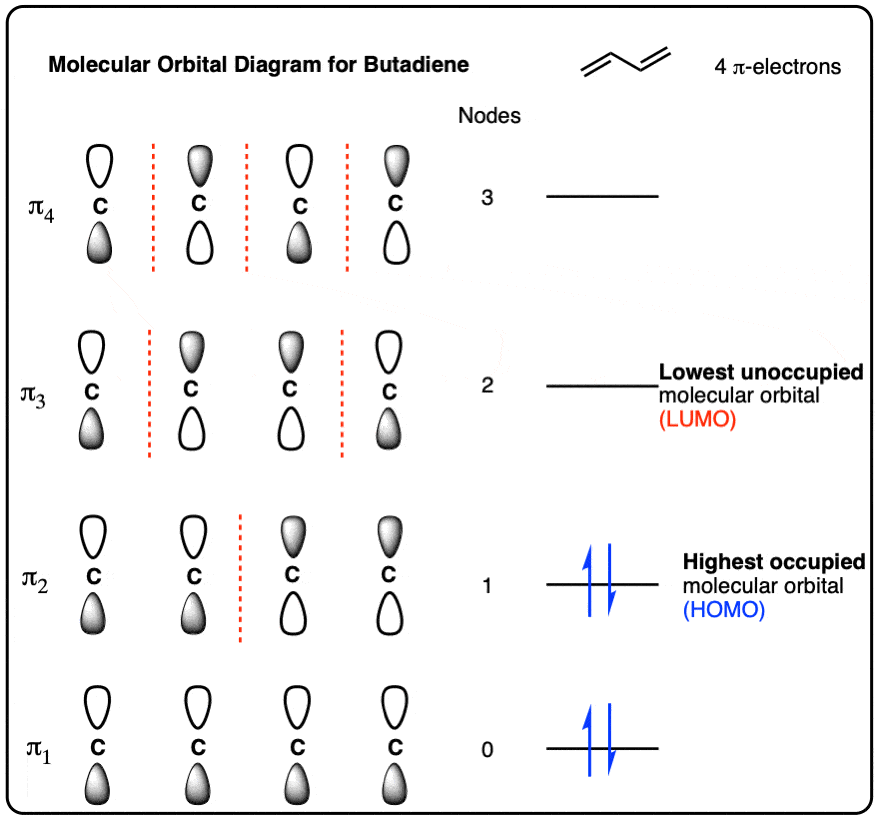
Table of Contents
- Helpful Hints On Drawing The Pi Molecular Orbitals Of A Conjugated System: A Quick Review
- The Butadienyl Pi System (n = 4)
- The Lowest-Energy Molecular Orbital (π1) Of The Butadiene Pi System Has Zero Nodes
- The Highest-Energy Molecular Orbital (π4) Has Three Nodes
- The Second-Lowest-Energy Molecular Orbital (π2) Has One Node
- The Third-Lowest-Energy Molecular Orbital (π3) Has Two Nodes
- The Full Molecular Orbital Diagram For The Butadienyl System (n=4)
- Populating The Molecular Orbitals Of Butadiene With Electrons
- Identifying The “HOMO” And “LUMO” Of Butadiene
- Notes
- (Advanced) References and Further Reading
1. Drawing The Pi Molecular Orbitals Of A Conjugated System: A Quick Review
In the last post in this series we built up the pi molecular orbitals of the allyl pi-system, consisting of three consecutive p orbitals in conjugation. In this article we will show how to build the pi molecular orbital diagram of butadiene.
In the last post, we saw that:
- The number of molecular orbitals (n) for a pi-system is equal to the number of contributing p orbitals. For the allyl system, n=3. We had three contributing p orbitals and thus three pi molecular orbitals.
- The lowest-energy orbital always has zero nodes between the p-orbitals (note that we say “no nodes between the p-orbitals” because we’re not counting the node between the individual lobes, which is inherent to all p-orbitals). That is, in the lowest-energy orbital, all phases of the contributing p-orbitals are aligned the same way.

- The number of nodes between p-orbitals increases by 1 for each successive energy level, such that the highest-energy orbital has (n-1) nodes (all phases of contributing p-orbitals alternate).

- The lowest and highest energy orbitals are always the easiest pi molecular orbitals to draw. It’s helpful to draw them first.
- The trick to drawing the orbital(s) of intermediate energy is to understand where to put the node(s). Nodes are positioned in a way such that they are symmetrical relative to the centre. A system with 1 node has the node smack in the centre (right on the central atom, in fact). A system with 2 nodes will have the nodes at equal distance relative to the centre.
- It’s helpful to draw out all the orbitals of the pi system first, and then add the pi-electrons to it.
Today’s post actually doesn’t introduce any new concepts. We’re just going to take everything from the previous post on building up the orbitals of the allyl system (n=3) and apply it towards drawing the orbitals of the butadienyl system (n=4).
We’ll gain a full appreciation of the importance of the molecular orbitals for butadiene in a little while when we start exploring a curious little reaction discovered by Otto Diels and Kurt Alder back in 1928.
2. The Butadienyl Pi System (n = 4)
As the name suggests, butadiene is composed of 4 carbons with two adjacent pi bonds. As we showed in this earlier post on conjugation and resonance, these two pi bonds are conjugated : all four p orbitals are all aligned with each other, and build up into a larger pi system. It’s for this reason that we can describe the electron density in butadiene with resonance forms, which show alternative distributions of pi electrons in the molecule.

Since butadiene consists of 4 individual p orbitals, the pi-system of butadiene will contain 4 pi molecular orbitals.
Using the principles we learned from drawing out the pi molecular orbitals of the allyl system, let’s try to draw out what each of these four molecular orbitals should look like.
3. The Lowest-Energy Molecular Orbital (π1) Of The Butadiene Pi System Has Zero Nodes
The lowest energy molecular orbital will have p orbitals with phases in complete alignment with each other. This is very easy to draw: just draw four consecutive p-orbitals with their lobes aligned the same way.
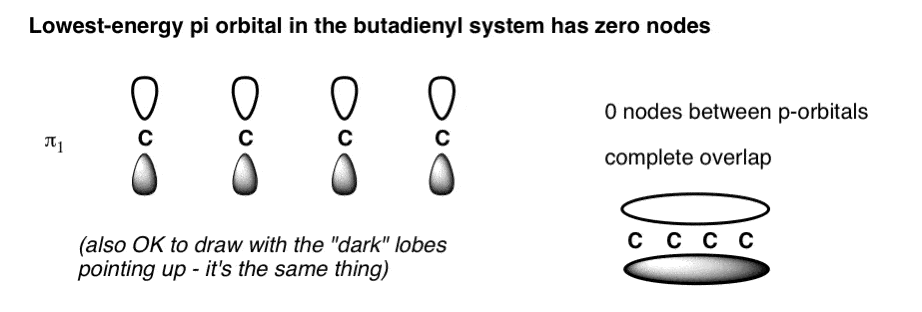
We could have also drawn the pi-system with all the shaded lobes pointing up: it’s the same thing. The constructive overlap between the lobes results in a pi orbital that extends over the entire length of the pi system (above right); there are zero nodes between the p orbitals themselves. A physical interpretation of this orbital is that an electron in this orbital is delocalized over the length of the pi system. [Note 2]
4. The Highest-Energy Molecular Orbital (π4) Has Three Nodes
The highest-energy molecular orbital is also very easy to draw. Just draw n (4 in our case) p orbitals and alternate the phases of each. This creates a pi system with three nodes (areas where the lobes change sign). We’ve drawn the nodes in as red dotted lines.

5. The Second-Lowest-Energy Molecular Orbital (π2) Has One Node
The second-lowest-energy molecular orbital in butadiene will have 1 node. The trick is knowing where to put it.
As we saw with the allyl system, the node cannot just be placed anywhere; the mathematical properties of the Schrödinger wave equation (which we don’t need to get into) dictate its position. Thankfully, node placement for this orbital is pretty straightforward: just plunk it in the middle.(This goes for all systems with a single node, by the way).
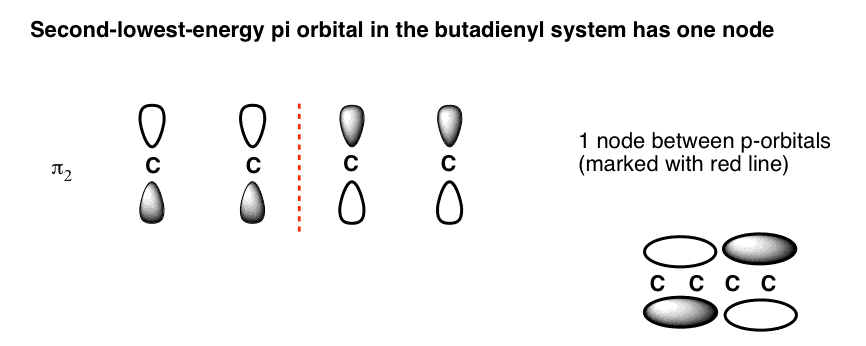
Note how the phases flip in the centre of the pi orbital. This corresponds to the situation we’d expect to see for two adjacent non-interacting pi bonds, where the electrons are each confined to pi orbitals spanning two carbons each, with a node in the middle (above right).
6. The Third-Lowest-Energy Molecular Orbital (π3) Has Two Nodes
Finally we come to the third-lowest-energy molecular orbital (or second-highest, if you prefer). This has two nodes.
Where to place them?
The general principle is that they are placed symmetrically with respect to the centre. This is what the orbital picture looks like: [Note 2]
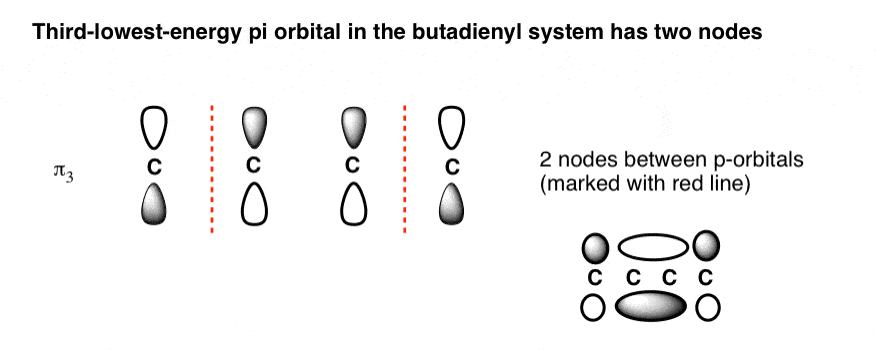
This gives us a 2-carbon pi orbital in the centre flanked by two one-carbon orbitals on the sides.
7. The Full Molecular Orbital Diagram For The Butadienyl System (n=4)
Now that we have all the pieces, all we need to do to construct the molecular orbital diagram for the butadienyl system is to arrange the orbitals in order of increasing energy. That gives us the following figure (note that we haven’t added any electrons to it yet).
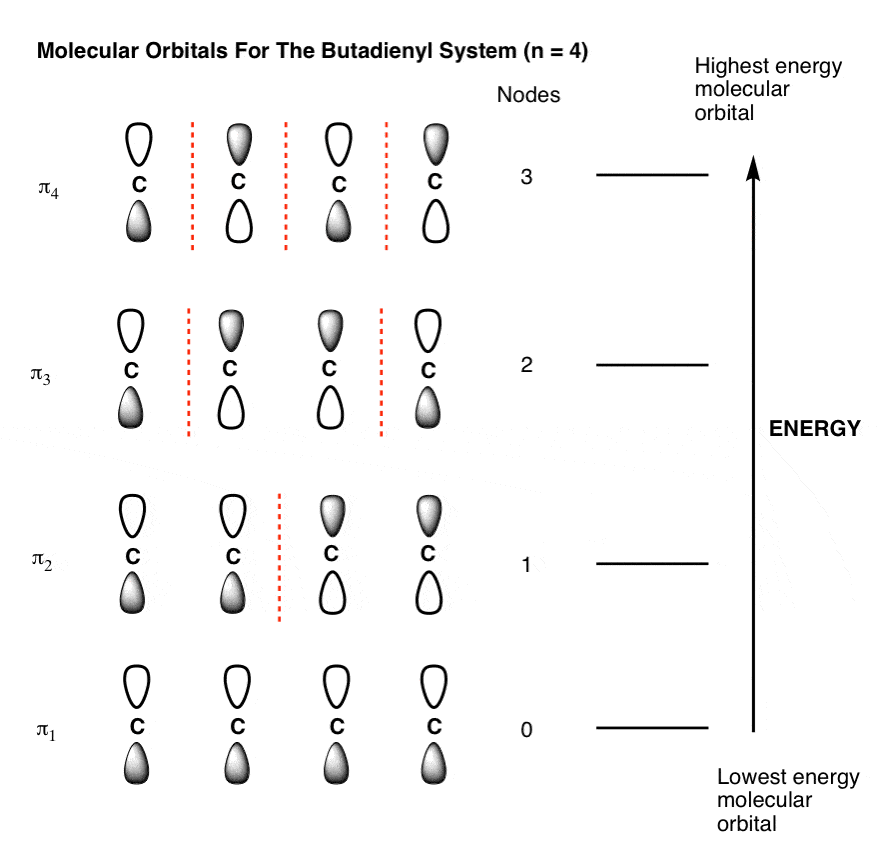
A molecular orbital diagram without electrons is like an apartment building without people. So let’s pick the simplest possible molecule to apply to this system: butadiene.
8. Populating The Molecular Orbitals Of Butadiene With Electrons
Butadiene has two double bonds with two electrons each, for a total of 4 pi electrons. We fill up the lowest-energy molecular orbitals first, which gives us the following:
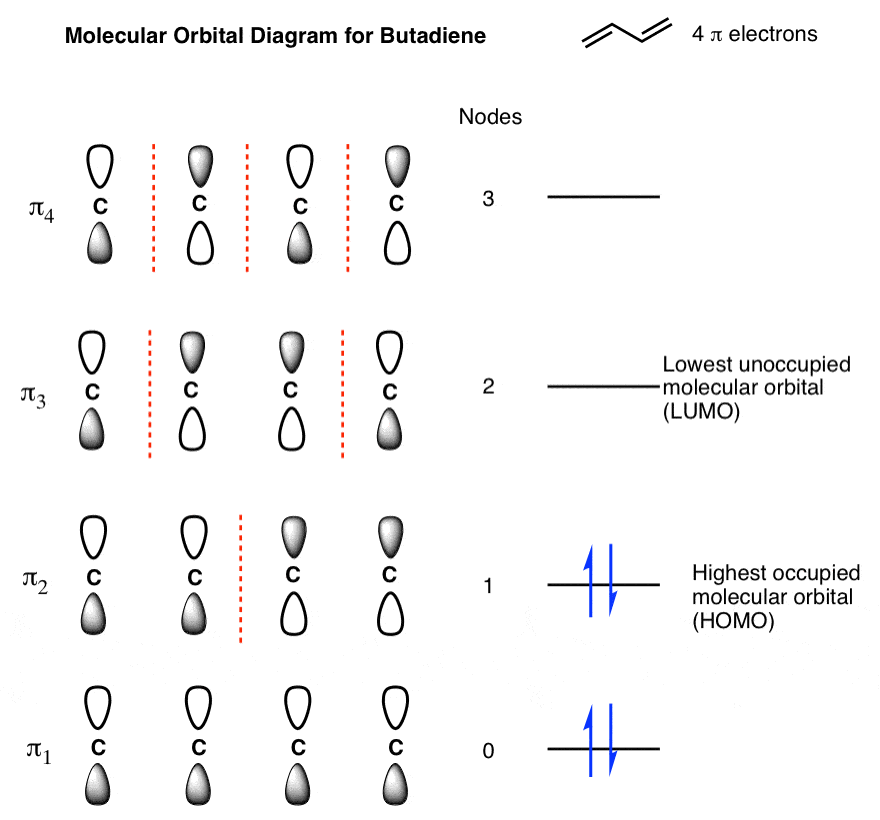
We’ve highlighted two molecular orbitals on this diagram as being of particular interest, because, as we’ll see, they’re where the action usually happens. The are sometimes called the “frontier” orbitals.
9. Identifying The “HOMO” And “LUMO” Of Butadiene
The highest occupied molecular orbital (HOMO) is π2. You can think of the HOMO as being a little bit like the “valence electrons” of the pi system: they’re the most readily lost. If butadiene participates in a reaction where it is the electron-donor (nucleophile), its electrons are going to come from that orbital.
The lowest-unoccupied molecular orbital (LUMO) is π3. The LUMO is the lowest-energy unoccupied orbital. If butadiene participates in a reaction where it is the electron acceptor (electrophile), the electrons will be donated to that orbital.
We’ll have more to say about the HOMO and LUMO shortly, but that’s sufficient for now.
Now here’s a quiz for you, based on what we’ve gone through today:
- How would you draw the molecular orbital diagram for the pentadienyl cation (n = 5) ?
- Can you draw the MO diagram of the butadienyl radical anion?

Answers below. [Note 3]
Thanks to Thomas Struble for assistance with this post.
Notes
Related Articles
Note 1. I don’t want to get into Particle In A Box, but if you look at electrons as waves and think about their energies according to E = hν , the longer the “box” an electron is confined to, the lower its energy will be. This is a quick argument as to why delocalization of electrons is energetically favourable.
Note 2. Not going to touch the Hückel treatment of molecular orbitals here. Fleming, “Frontier Orbitals and Organic Chemical Reactions” is the place to go if you’re curious for a rigorous yet practical treatment of molecular orbital theory.
Note 3. Answers. Pentadienyl cation:
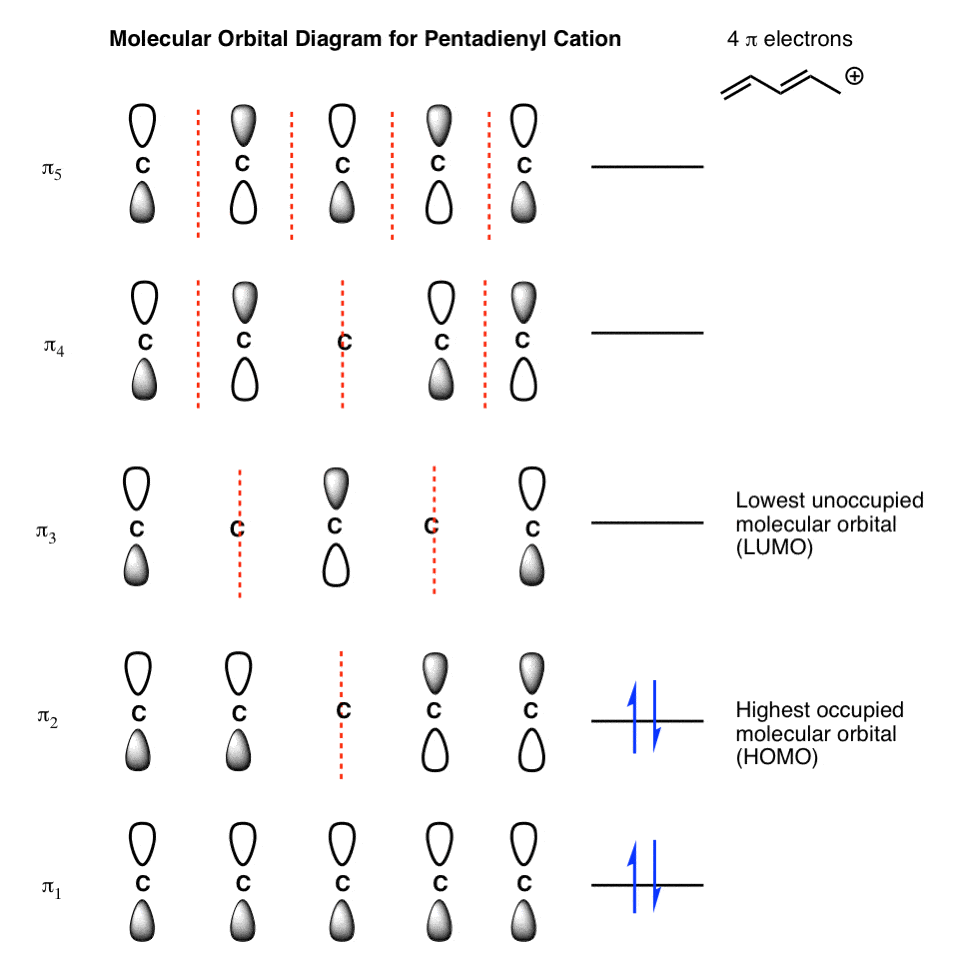
Butadienyl radical anion: just take our MO diagram for butadiene, and put an electron in π3 (i.e. the LUMO of butadiene). It’s really that simple.
(Advanced) References and Further Reading
Structure of butadiene using calculations from Rowan:
C1-C2 (pi) bond length: 1.319 Å
C2-C3 (sigma) bond length: 1.489 Å (normal C-C bond length: 1.51 Å )
Butadiene molecular orbital calculations from Rowan:
00 General Chemistry Review
01 Bonding, Structure, and Resonance
- How Do We Know Methane (CH4) Is Tetrahedral?
- Hybrid Orbitals and Hybridization
- How To Determine Hybridization: A Shortcut
- Orbital Hybridization And Bond Strengths
- Sigma bonds come in six varieties: Pi bonds come in one
- A Key Skill: How to Calculate Formal Charge
- The Four Intermolecular Forces and How They Affect Boiling Points
- 3 Trends That Affect Boiling Points
- How To Use Electronegativity To Determine Electron Density (and why NOT to trust formal charge)
- Introduction to Resonance
- How To Use Curved Arrows To Interchange Resonance Forms
- Evaluating Resonance Forms (1) - The Rule of Least Charges
- How To Find The Best Resonance Structure By Applying Electronegativity
- Evaluating Resonance Structures With Negative Charges
- Evaluating Resonance Structures With Positive Charge
- Exploring Resonance: Pi-Donation
- Exploring Resonance: Pi-acceptors
- In Summary: Evaluating Resonance Structures
- Drawing Resonance Structures: 3 Common Mistakes To Avoid
- How to apply electronegativity and resonance to understand reactivity
- Bond Hybridization Practice
- Structure and Bonding Practice Quizzes
- Resonance Structures Practice
02 Acid Base Reactions
- Introduction to Acid-Base Reactions
- Acid Base Reactions In Organic Chemistry
- The Stronger The Acid, The Weaker The Conjugate Base
- Walkthrough of Acid-Base Reactions (3) - Acidity Trends
- Five Key Factors That Influence Acidity
- Acid-Base Reactions: Introducing Ka and pKa
- How to Use a pKa Table
- The pKa Table Is Your Friend
- A Handy Rule of Thumb for Acid-Base Reactions
- Acid Base Reactions Are Fast
- pKa Values Span 60 Orders Of Magnitude
- How Protonation and Deprotonation Affect Reactivity
- Acid Base Practice Problems
03 Alkanes and Nomenclature
- Meet the (Most Important) Functional Groups
- Condensed Formulas: Deciphering What the Brackets Mean
- Hidden Hydrogens, Hidden Lone Pairs, Hidden Counterions
- Don't Be Futyl, Learn The Butyls
- Primary, Secondary, Tertiary, Quaternary In Organic Chemistry
- Branching, and Its Affect On Melting and Boiling Points
- The Many, Many Ways of Drawing Butane
- Wedge And Dash Convention For Tetrahedral Carbon
- Common Mistakes in Organic Chemistry: Pentavalent Carbon
- Table of Functional Group Priorities for Nomenclature
- Summary Sheet - Alkane Nomenclature
- Organic Chemistry IUPAC Nomenclature Demystified With A Simple Puzzle Piece Approach
- Boiling Point Quizzes
- Organic Chemistry Nomenclature Quizzes
04 Conformations and Cycloalkanes
- Staggered vs Eclipsed Conformations of Ethane
- Conformational Isomers of Propane
- Newman Projection of Butane (and Gauche Conformation)
- Introduction to Cycloalkanes
- Geometric Isomers In Small Rings: Cis And Trans Cycloalkanes
- Calculation of Ring Strain In Cycloalkanes
- Cycloalkanes - Ring Strain In Cyclopropane And Cyclobutane
- Cyclohexane Conformations
- Cyclohexane Chair Conformation: An Aerial Tour
- How To Draw The Cyclohexane Chair Conformation
- The Cyclohexane Chair Flip
- The Cyclohexane Chair Flip - Energy Diagram
- Substituted Cyclohexanes - Axial vs Equatorial
- Ranking The Bulkiness Of Substituents On Cyclohexanes: "A-Values"
- Cyclohexane Chair Conformation Stability: Which One Is Lower Energy?
- Fused Rings - Cis-Decalin and Trans-Decalin
- Naming Bicyclic Compounds - Fused, Bridged, and Spiro
- Bredt's Rule (And Summary of Cycloalkanes)
- Newman Projection Practice
- Cycloalkanes Practice Problems
05 A Primer On Organic Reactions
- The Most Important Question To Ask When Learning a New Reaction
- Curved Arrows (for reactions)
- Nucleophiles and Electrophiles
- The Three Classes of Nucleophiles
- Nucleophilicity vs. Basicity
- What Makes A Good Nucleophile?
- What Makes A Good Leaving Group?
- 3 Factors That Stabilize Carbocations
- Equilibrium and Energy Relationships
- 7 Factors that stabilize negative charge in organic chemistry
- 7 Factors That Stabilize Positive Charge in Organic Chemistry
- What's a Transition State?
- Hammond's Postulate
- Learning Organic Chemistry Reactions: A Checklist (PDF)
- Introduction to Oxidative Cleavage Reactions
06 Free Radical Reactions
- Bond Dissociation Energies = Homolytic Cleavage
- Free Radical Reactions
- 3 Factors That Stabilize Free Radicals
- What Factors Destabilize Free Radicals?
- Bond Strengths And Radical Stability
- Free Radical Initiation: Why Is "Light" Or "Heat" Required?
- Initiation, Propagation, Termination
- Monochlorination Products Of Propane, Pentane, And Other Alkanes
- Selectivity In Free Radical Reactions
- Selectivity in Free Radical Reactions: Bromination vs. Chlorination
- Halogenation At Tiffany's
- Allylic Bromination
- Bonus Topic: Allylic Rearrangements
- In Summary: Free Radicals
- Synthesis (2) - Reactions of Alkanes
- Free Radicals Practice Quizzes
07 Stereochemistry and Chirality
- Types of Isomers: Constitutional Isomers, Stereoisomers, Enantiomers, and Diastereomers
- How To Draw The Enantiomer Of A Chiral Molecule
- How To Draw A Bond Rotation
- Introduction to Assigning (R) and (S): The Cahn-Ingold-Prelog Rules
- Assigning Cahn-Ingold-Prelog (CIP) Priorities (2) - The Method of Dots
- Enantiomers vs Diastereomers vs The Same? Two Methods For Solving Problems
- Assigning R/S To Newman Projections (And Converting Newman To Line Diagrams)
- How To Determine R and S Configurations On A Fischer Projection
- The Meso Trap
- Optical Rotation, Optical Activity, and Specific Rotation
- Optical Purity and Enantiomeric Excess
- What's a Racemic Mixture?
- Chiral Allenes And Chiral Axes
- Stereochemistry Practice Problems and Quizzes
08 Substitution Reactions
- Nucleophilic Substitution Reactions - Introduction
- Two Types of Nucleophilic Substitution Reactions
- The SN2 Mechanism
- Why the SN2 Reaction Is Powerful
- The SN1 Mechanism
- The Conjugate Acid Is A Better Leaving Group
- Comparing the SN1 and SN2 Reactions
- Polar Protic? Polar Aprotic? Nonpolar? All About Solvents
- Steric Hindrance is Like a Fat Goalie
- Common Blind Spot: Intramolecular Reactions
- Substitution Practice - SN1
- Substitution Practice - SN2
09 Elimination Reactions
- Elimination Reactions (1): Introduction And The Key Pattern
- Elimination Reactions (2): The Zaitsev Rule
- Elimination Reactions Are Favored By Heat
- Two Elimination Reaction Patterns
- The E1 Reaction
- The E2 Mechanism
- E1 vs E2: Comparing the E1 and E2 Reactions
- Antiperiplanar Relationships: The E2 Reaction and Cyclohexane Rings
- Bulky Bases in Elimination Reactions
- Comparing the E1 vs SN1 Reactions
- Elimination (E1) Reactions With Rearrangements
- E1cB - Elimination (Unimolecular) Conjugate Base
- Elimination (E1) Practice Problems And Solutions
- Elimination (E2) Practice Problems and Solutions
10 Rearrangements
11 SN1/SN2/E1/E2 Decision
- Identifying Where Substitution and Elimination Reactions Happen
- Deciding SN1/SN2/E1/E2 (1) - The Substrate
- Deciding SN1/SN2/E1/E2 (2) - The Nucleophile/Base
- SN1 vs E1 and SN2 vs E2 : The Temperature
- Deciding SN1/SN2/E1/E2 - The Solvent
- Wrapup: The Key Factors For Determining SN1/SN2/E1/E2
- Alkyl Halide Reaction Map And Summary
- SN1 SN2 E1 E2 Practice Problems
12 Alkene Reactions
- E and Z Notation For Alkenes (+ Cis/Trans)
- Alkene Stability
- Alkene Addition Reactions: "Regioselectivity" and "Stereoselectivity" (Syn/Anti)
- Stereoselective and Stereospecific Reactions
- Hydrohalogenation of Alkenes and Markovnikov's Rule
- Hydration of Alkenes With Aqueous Acid
- Rearrangements in Alkene Addition Reactions
- Halogenation of Alkenes and Halohydrin Formation
- Oxymercuration Demercuration of Alkenes
- Hydroboration Oxidation of Alkenes
- m-CPBA (meta-chloroperoxybenzoic acid)
- OsO4 (Osmium Tetroxide) for Dihydroxylation of Alkenes
- Palladium on Carbon (Pd/C) for Catalytic Hydrogenation of Alkenes
- Cyclopropanation of Alkenes
- A Fourth Alkene Addition Pattern - Free Radical Addition
- Alkene Reactions: Ozonolysis
- Summary: Three Key Families Of Alkene Reaction Mechanisms
- Synthesis (4) - Alkene Reaction Map, Including Alkyl Halide Reactions
- Alkene Reactions Practice Problems
13 Alkyne Reactions
- Acetylides from Alkynes, And Substitution Reactions of Acetylides
- Partial Reduction of Alkynes With Lindlar's Catalyst
- Partial Reduction of Alkynes With Na/NH3 To Obtain Trans Alkenes
- Alkyne Hydroboration With "R2BH"
- Hydration and Oxymercuration of Alkynes
- Hydrohalogenation of Alkynes
- Alkyne Halogenation: Bromination, Chlorination, and Iodination of Alkynes
- Alkyne Reactions - The "Concerted" Pathway
- Alkenes To Alkynes Via Halogenation And Elimination Reactions
- Alkynes Are A Blank Canvas
- Synthesis (5) - Reactions of Alkynes
- Alkyne Reactions Practice Problems With Answers
14 Alcohols, Epoxides and Ethers
- Alcohols - Nomenclature and Properties
- Alcohols Can Act As Acids Or Bases (And Why It Matters)
- Alcohols - Acidity and Basicity
- The Williamson Ether Synthesis
- Ethers From Alkenes, Tertiary Alkyl Halides and Alkoxymercuration
- Alcohols To Ethers via Acid Catalysis
- Cleavage Of Ethers With Acid
- Epoxides - The Outlier Of The Ether Family
- Opening of Epoxides With Acid
- Epoxide Ring Opening With Base
- Making Alkyl Halides From Alcohols
- Tosylates And Mesylates
- PBr3 and SOCl2
- Elimination Reactions of Alcohols
- Elimination of Alcohols To Alkenes With POCl3
- Alcohol Oxidation: "Strong" and "Weak" Oxidants
- Demystifying The Mechanisms of Alcohol Oxidations
- Protecting Groups For Alcohols
- Thiols And Thioethers
- Calculating the oxidation state of a carbon
- Oxidation and Reduction in Organic Chemistry
- Oxidation Ladders
- SOCl2 Mechanism For Alcohols To Alkyl Halides: SN2 versus SNi
- Alcohol Reactions Roadmap (PDF)
- Alcohol Reaction Practice Problems
- Epoxide Reaction Quizzes
- Oxidation and Reduction Practice Quizzes
15 Organometallics
- What's An Organometallic?
- Formation of Grignard and Organolithium Reagents
- Organometallics Are Strong Bases
- Reactions of Grignard Reagents
- Protecting Groups In Grignard Reactions
- Synthesis Problems Involving Grignard Reagents
- Grignard Reactions And Synthesis (2)
- Organocuprates (Gilman Reagents): How They're Made
- Gilman Reagents (Organocuprates): What They're Used For
- The Heck, Suzuki, and Olefin Metathesis Reactions (And Why They Don't Belong In Most Introductory Organic Chemistry Courses)
- Reaction Map: Reactions of Organometallics
- Grignard Practice Problems
16 Spectroscopy
- Degrees of Unsaturation (or IHD, Index of Hydrogen Deficiency)
- Conjugation And Color (+ How Bleach Works)
- Introduction To UV-Vis Spectroscopy
- UV-Vis Spectroscopy: Absorbance of Carbonyls
- UV-Vis Spectroscopy: Practice Questions
- Bond Vibrations, Infrared Spectroscopy, and the "Ball and Spring" Model
- Infrared Spectroscopy: A Quick Primer On Interpreting Spectra
- IR Spectroscopy: 4 Practice Problems
- 1H NMR: How Many Signals?
- Homotopic, Enantiotopic, Diastereotopic
- Diastereotopic Protons in 1H NMR Spectroscopy: Examples
- 13-C NMR - How Many Signals
- Liquid Gold: Pheromones In Doe Urine
- Natural Product Isolation (1) - Extraction
- Natural Product Isolation (2) - Purification Techniques, An Overview
- Structure Determination Case Study: Deer Tarsal Gland Pheromone
17 Dienes and MO Theory
- What To Expect In Organic Chemistry 2
- Are these molecules conjugated?
- Conjugation And Resonance In Organic Chemistry
- Bonding And Antibonding Pi Orbitals
- Molecular Orbitals of The Allyl Cation, Allyl Radical, and Allyl Anion
- Pi Molecular Orbitals of Butadiene
- Reactions of Dienes: 1,2 and 1,4 Addition
- Thermodynamic and Kinetic Products
- More On 1,2 and 1,4 Additions To Dienes
- s-cis and s-trans
- The Diels-Alder Reaction
- Cyclic Dienes and Dienophiles in the Diels-Alder Reaction
- Stereochemistry of the Diels-Alder Reaction
- Exo vs Endo Products In The Diels Alder: How To Tell Them Apart
- HOMO and LUMO In the Diels Alder Reaction
- Why Are Endo vs Exo Products Favored in the Diels-Alder Reaction?
- Diels-Alder Reaction: Kinetic and Thermodynamic Control
- The Retro Diels-Alder Reaction
- The Intramolecular Diels Alder Reaction
- Regiochemistry In The Diels-Alder Reaction
- The Cope and Claisen Rearrangements
- Electrocyclic Reactions
- Electrocyclic Ring Opening And Closure (2) - Six (or Eight) Pi Electrons
- Diels Alder Practice Problems
- Molecular Orbital Theory Practice
18 Aromaticity
- Introduction To Aromaticity
- Rules For Aromaticity
- Huckel's Rule: What Does 4n+2 Mean?
- Aromatic, Non-Aromatic, or Antiaromatic? Some Practice Problems
- Antiaromatic Compounds and Antiaromaticity
- The Pi Molecular Orbitals of Benzene
- The Pi Molecular Orbitals of Cyclobutadiene
- Frost Circles
- Aromaticity Practice Quizzes
19 Reactions of Aromatic Molecules
- Electrophilic Aromatic Substitution: Introduction
- Activating and Deactivating Groups In Electrophilic Aromatic Substitution
- Electrophilic Aromatic Substitution - The Mechanism
- Ortho-, Para- and Meta- Directors in Electrophilic Aromatic Substitution
- Understanding Ortho, Para, and Meta Directors
- Why are halogens ortho- para- directors?
- Disubstituted Benzenes: The Strongest Electron-Donor "Wins"
- Electrophilic Aromatic Substitutions (1) - Halogenation of Benzene
- Electrophilic Aromatic Substitutions (2) - Nitration and Sulfonation
- EAS Reactions (3) - Friedel-Crafts Acylation and Friedel-Crafts Alkylation
- Intramolecular Friedel-Crafts Reactions
- Nucleophilic Aromatic Substitution (NAS)
- Nucleophilic Aromatic Substitution (2) - The Benzyne Mechanism
- Reactions on the "Benzylic" Carbon: Bromination And Oxidation
- The Wolff-Kishner, Clemmensen, And Other Carbonyl Reductions
- More Reactions on the Aromatic Sidechain: Reduction of Nitro Groups and the Baeyer Villiger
- Aromatic Synthesis (1) - "Order Of Operations"
- Synthesis of Benzene Derivatives (2) - Polarity Reversal
- Aromatic Synthesis (3) - Sulfonyl Blocking Groups
- Birch Reduction
- Synthesis (7): Reaction Map of Benzene and Related Aromatic Compounds
- Aromatic Reactions and Synthesis Practice
- Electrophilic Aromatic Substitution Practice Problems
20 Aldehydes and Ketones
- What's The Alpha Carbon In Carbonyl Compounds?
- Nucleophilic Addition To Carbonyls
- Aldehydes and Ketones: 14 Reactions With The Same Mechanism
- Sodium Borohydride (NaBH4) Reduction of Aldehydes and Ketones
- Grignard Reagents For Addition To Aldehydes and Ketones
- Wittig Reaction
- Hydrates, Hemiacetals, and Acetals
- Imines - Properties, Formation, Reactions, and Mechanisms
- All About Enamines
- Breaking Down Carbonyl Reaction Mechanisms: Reactions of Anionic Nucleophiles (Part 2)
- Aldehydes Ketones Reaction Practice
21 Carboxylic Acid Derivatives
- Nucleophilic Acyl Substitution (With Negatively Charged Nucleophiles)
- Addition-Elimination Mechanisms With Neutral Nucleophiles (Including Acid Catalysis)
- Basic Hydrolysis of Esters - Saponification
- Transesterification
- Proton Transfer
- Fischer Esterification - Carboxylic Acid to Ester Under Acidic Conditions
- Lithium Aluminum Hydride (LiAlH4) For Reduction of Carboxylic Acid Derivatives
- LiAlH[Ot-Bu]3 For The Reduction of Acid Halides To Aldehydes
- Di-isobutyl Aluminum Hydride (DIBAL) For The Partial Reduction of Esters and Nitriles
- Amide Hydrolysis
- Thionyl Chloride (SOCl2)
- Diazomethane (CH2N2)
- Carbonyl Chemistry: Learn Six Mechanisms For the Price Of One
- Making Music With Mechanisms (PADPED)
- Carboxylic Acid Derivatives Practice Questions
22 Enols and Enolates
- Keto-Enol Tautomerism
- Enolates - Formation, Stability, and Simple Reactions
- Kinetic Versus Thermodynamic Enolates
- Aldol Addition and Condensation Reactions
- Reactions of Enols - Acid-Catalyzed Aldol, Halogenation, and Mannich Reactions
- Claisen Condensation and Dieckmann Condensation
- Decarboxylation
- The Malonic Ester and Acetoacetic Ester Synthesis
- The Michael Addition Reaction and Conjugate Addition
- The Robinson Annulation
- Haloform Reaction
- The Hell–Volhard–Zelinsky Reaction
- Enols and Enolates Practice Quizzes
23 Amines
- The Amide Functional Group: Properties, Synthesis, and Nomenclature
- Basicity of Amines And pKaH
- 5 Key Basicity Trends of Amines
- The Mesomeric Effect And Aromatic Amines
- Nucleophilicity of Amines
- Alkylation of Amines (Sucks!)
- Reductive Amination
- The Gabriel Synthesis
- Some Reactions of Azides
- The Hofmann Elimination
- The Hofmann and Curtius Rearrangements
- The Cope Elimination
- Protecting Groups for Amines - Carbamates
- The Strecker Synthesis of Amino Acids
- Introduction to Peptide Synthesis
- Reactions of Diazonium Salts: Sandmeyer and Related Reactions
- Amine Practice Questions
24 Carbohydrates
- D and L Notation For Sugars
- Pyranoses and Furanoses: Ring-Chain Tautomerism In Sugars
- What is Mutarotation?
- Reducing Sugars
- The Big Damn Post Of Carbohydrate-Related Chemistry Definitions
- The Haworth Projection
- Converting a Fischer Projection To A Haworth (And Vice Versa)
- Reactions of Sugars: Glycosylation and Protection
- The Ruff Degradation and Kiliani-Fischer Synthesis
- Isoelectric Points of Amino Acids (and How To Calculate Them)
- Carbohydrates Practice
- Amino Acid Quizzes
25 Fun and Miscellaneous
- A Gallery of Some Interesting Molecules From Nature
- Screw Organic Chemistry, I'm Just Going To Write About Cats
- On Cats, Part 1: Conformations and Configurations
- On Cats, Part 2: Cat Line Diagrams
- On Cats, Part 4: Enantiocats
- On Cats, Part 6: Stereocenters
- Organic Chemistry Is Shit
- The Organic Chemistry Behind "The Pill"
- Maybe they should call them, "Formal Wins" ?
- Why Do Organic Chemists Use Kilocalories?
- The Principle of Least Effort
- Organic Chemistry GIFS - Resonance Forms
- Reproducibility In Organic Chemistry
- What Holds The Nucleus Together?
- How Reactions Are Like Music
- Organic Chemistry and the New MCAT
26 Organic Chemistry Tips and Tricks
- Common Mistakes: Formal Charges Can Mislead
- Partial Charges Give Clues About Electron Flow
- Draw The Ugly Version First
- Organic Chemistry Study Tips: Learn the Trends
- The 8 Types of Arrows In Organic Chemistry, Explained
- Top 10 Skills To Master Before An Organic Chemistry 2 Final
- Common Mistakes with Carbonyls: Carboxylic Acids... Are Acids!
- Planning Organic Synthesis With "Reaction Maps"
- Alkene Addition Pattern #1: The "Carbocation Pathway"
- Alkene Addition Pattern #2: The "Three-Membered Ring" Pathway
- Alkene Addition Pattern #3: The "Concerted" Pathway
- Number Your Carbons!
- The 4 Major Classes of Reactions in Org 1
- How (and why) electrons flow
- Grossman's Rule
- Three Exam Tips
- A 3-Step Method For Thinking Through Synthesis Problems
- Putting It Together
- Putting Diels-Alder Products in Perspective
- The Ups and Downs of Cyclohexanes
- The Most Annoying Exceptions in Org 1 (Part 1)
- The Most Annoying Exceptions in Org 1 (Part 2)
- The Marriage May Be Bad, But the Divorce Still Costs Money
- 9 Nomenclature Conventions To Know
- Nucleophile attacks Electrophile
27 Case Studies of Successful O-Chem Students
- Success Stories: How Corina Got The The "Hard" Professor - And Got An A+ Anyway
- How Helena Aced Organic Chemistry
- From a "Drop" To B+ in Org 2 – How A Hard Working Student Turned It Around
- How Serge Aced Organic Chemistry
- Success Stories: How Zach Aced Organic Chemistry 1
- Success Stories: How Kari Went From C– to B+
- How Esther Bounced Back From a "C" To Get A's In Organic Chemistry 1 And 2
- How Tyrell Got The Highest Grade In Her Organic Chemistry Course
- This Is Why Students Use Flashcards
- Success Stories: How Stu Aced Organic Chemistry
- How John Pulled Up His Organic Chemistry Exam Grades
- Success Stories: How Nathan Aced Organic Chemistry (Without It Taking Over His Life)
- How Chris Aced Org 1 and Org 2
- Interview: How Jay Got an A+ In Organic Chemistry
- How to Do Well in Organic Chemistry: One Student's Advice
- "America's Top TA" Shares His Secrets For Teaching O-Chem
- "Organic Chemistry Is Like..." - A Few Metaphors
- How To Do Well In Organic Chemistry: Advice From A Tutor
- Guest post: "I went from being afraid of tests to actually looking forward to them".
Can you please provide the molecular orbitals for heptatrienyl system (for radical, cation, anion) ??
Well, you’d have 7 p orbitals. The lowest energy MO (pi-1) would have all of the lobes facing the same way (zero nodes). The highest energy MO (pi 7) would have all p-orbital lobes alternating (6 nodes).
It will resemble allyl and pentadienyl in that the second-lowest orbital (pi 2) will have a node right on the central carbon. In the pi 4 and pi 6 orbitals there will also be a node on the central carbon, in addition to additional nodes.
The rest of the pi orbitals you can build up based on the principle that the number of nodes increases by 1 for each energy level, and also that the nodes should be placed symmetrically about the pi system.
Once you build up the seven pi orbitals of the heptatrienyl system, then you just need to fill it with orbitals. The cation will have 6 pi electrons, the radical 7 pi electrons, and the anion 8 pi electrons.
Could be wrong but check formal charge on carbon 4 of butadienyl radical anion figure near invitation to draw mo diagram. I figure 2-, and I think to be part of the pi system that carbon should be sp2 hybridized. Should if be CH2-CH-CH-CH2 ?
Shoot. Thanks Len. Fixed!
Will it be the same for 1,2-butadiene? bcoz in this molecule only 3 C are involved in pi bonding. The last carbon is not involved in pi bonding. So the total no.of pi orbitals will be 3 ryt?
No it will not be the same for 1,2-butadiene. If you look at the orbitals in 1,2-butadiene they are at right angles to each other, and are not conjugated. They therefore behave much like two separate pi bonds, not a conjugated system. The analysis in this post does not apply to 1,2-butadiene.
See: https://www.masterorganicchemistry.com/2015/01/13/chiral-allenes-and-chiral-axes/
Thanks for such a great explanation! I have a doubt: in pentadienyl system ,why u placed the two nodes ON carbon 2 and 4 in pi3 orbital.
As you said nodes can be placed at symmetric distance from the central carbon,so nodes should be placed BETWEEN carbon 2-3 and carbon 3-4 ? Why not so?
Great question. MO calculations, which I’m skipping over here, tell us that any odd-numbered MO in a system of odd-numbered orbitals (e.g. pi3 in the pentadienyl system) will have nodes coinciding with the positions of at least one of the carbons.
Thank you so much! This was very helpful. My professor covered molecular orbitals and determining the HOMO and LUMO so fast! Thanks for such a clear explanation.
Hi Fayeshun – it does tend to get treated rather quickly, I thought it might be helpful to develop this concept very slowly. If you found it helpful, great!
thank you so much your explanations are so fascinating and life saving
thank you a million
Thanks Shuaib – glad you found this article helpful.
Dear James,
Your answers are simple and straight forward, therefore easy to understand. And the questions are very relevant and important for any student of organic chemistry. I love your discussions.
Hi Ravi, I’m glad you found this post helpful. Thanks for using the site.